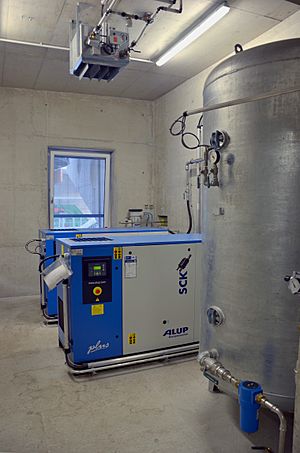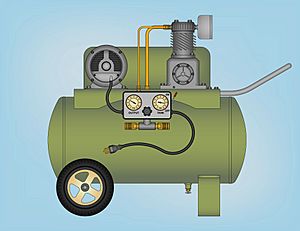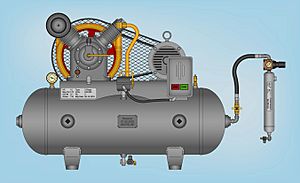Compressed air facts for kids
Compressed air is air kept under a pressure that is greater than atmospheric pressure.
Uses
In industry, compressed air is so widely used that it is often regarded as the fourth utility, after electricity, natural gas and water. However, compressed air is more expensive than the other three utilities when evaluated on a per unit energy delivered basis.
Compressed air is used for many purposes, including:
- Pneumatics, the use of pressurized gases to do work
- Pneumatic post, using capsules to move paper and small goods through tubes.
- Air tools
- HVAC control systems
- spray painting
- Vehicle propulsion (see compressed air vehicle)
- Energy storage (see compressed air energy storage)
- Recreation - Amusement Parks, Golf Courses (Sprinkler Systems), Hotel elevators, Ski Resorts (Snow making)
- Air brakes, including:
- railway braking systems
- road vehicle braking systems
- Underwater diving, for breathing, to inflate buoyancy compensator devices and lifting bags, and for airlift dredging
- Refrigeration using a vortex tube
- Air-start systems in engines
- Ammunition propulsion in:
- Cleaning dust and small debris in tiny spaces
- Abrasive blasting for removing corrosion products and coatings
- Injection molding
- Airbrushing used by model railroaders and other hobbyists to paint and weather cars, boats, planes and trains
- Food and beverage capping and fermentation
- Compressed air from Lysefjorden/Preikestolen (Norway) is being sold in cans, mostly to China.
In Europe, 10 percent of all industrial electricity consumption is to produce compressed air—amounting to 80 terawatt hours consumption per year.
Breathing
Air for breathing may be stored at high pressure and gradually released when needed, as in scuba diving, or produced continuously to meet requirements, as in surface-supplied diving. Air for breathing must be free of oil and other contaminants; carbon monoxide, for example, in trace volumetric fractions that might not be dangerous at normal atmospheric pressure may have deadly effects when breathing pressurized air due to proportionally higher partial pressure. Air compressors, filters, and supply systems intended for breathing air are not generally also used for pneumatic tools or other purposes, as air quality requirements differ.
Workers constructing the foundations of bridges or other structures may be working in a pressurized enclosure called a caisson, where water is prevented from entering the open bottom of the enclosure by filling it with air under pressure. It was known as early as the 17th century that workers in diving bells experienced shortness of breath and risked asphyxia, relieved by the release of fresh air into the bell. Such workers also experienced pain and other symptoms when returning to the surface, as the pressure was relieved. Denis Papin suggested in 1691 that the working time in a diving bell could be extended if fresh air from the surface was continually forced under pressure into the bell. By the 19th century, caissons were regularly used in civil construction, but workers experienced serious, sometimes fatal, symptoms on returning to the surface, a syndrome called caisson disease or decompression sickness. Many workers were killed by the disease on projects such as the Brooklyn Bridge and the Eads Bridge and it was not until the 1890s that it was understood that workers had to decompress slowly, to prevent the formation of dangerous bubbles in tissues.
Air under moderately high pressure, such as is used when diving below about 20 metres (70 ft), affects the nervous system. Nitrogen narcosis is a hazard when diving. For diving much beyond 30 metres (100 ft), it is less safe to use air alone and special breathing mixes containing helium are often used.
Design of systems
Compressor rooms must be designed with ventilation systems to remove waste heat produced by the compressors.
Water and oil vapor removal
When air at atmospheric pressure is compressed, it contains much more water vapor than the high-pressure air can hold. Relative humidity is governed by the properties of water and is not affected by air pressure. After compressed air cools, then the vaporized water turns to liquefied water.
Cooling the air as it leaves the compressor will take most of the moisture out before it gets into the piping. Aftercooler, storage tanks, etc. can help the compressed air cool to 104 °F; two-thirds of the water then turns to liquid.
Management of the excessive moisture is a requirement of a compressed air distribution system. System designers must ensure that piping maintains a slope, to prevent accumulation of moisture in low parts of the piping system. Drain valves may be installed at multiple points of a large system to allow trapped water to be blown out. Taps from piping headers may be arranged at the tops of pipes, so that moisture is not carried over into piping branches feeding equipment. Piping sizes are selected to avoid excessive energy loss in the piping system due to excess velocity in straight pipes at times of peak demand, or due to turbulence at pipe fittings.
See also
 In Spanish: Aire comprimido para niños
In Spanish: Aire comprimido para niños
- Air compressor
- Cabin pressurization
- Compressed air dryer
- Compressor
- Gas duster – (generally use fluorocarbons but some use compressed air.)
- Rotary-screw compressor




